The coffee table is a key part of any living room. Coffee Table Styling It’s more than a place for your coffee. It can change the whole feel of the room. So, how do you make your coffee table stand out?
Discover the secrets to making your coffee table a stunning centerpiece. It’s all about showing off your style and creating a beautiful space.
Key Takeaways
- Coffee table styling is a key part of a well-designed living room
- Styling a coffee table means understanding design, adding interest, and showing your style
- A good coffee table mixes looks and use, with books, decorations, and nature
- Styling a coffee table needs detail, like different heights, textures, and colors
- Adding useful and personal touches can make your coffee table look great
The Art of Coffee Table Styling
Starting to make your living space better begins with styling your coffee table. This area is a chance to show off your style and add interest. Learning about design basics, balance, and how to arrange things can turn your coffee table into a stunning focal point.
Understanding Basic Design Principles
Learning to style your coffee table starts with design basics. Key principles like rhythm, harmony, and emphasis are vital. They help create a balanced and attractive display that makes your living room look great.
Balance and Proportion Fundamentals
Getting the right balance and proportion on your coffee table is key. It makes your decor look cohesive and pleasing. By carefully placing your items, you can achieve a balanced look that’s both beautiful and practical.
Creating Visual Interest
A stylish coffee table should grab your attention and make you want to look closer. To achieve this, mix textures, try out new combinations, and add personal touches. Use the rule of three, vary heights, and mix materials for a lively and engaging table.
The art of coffee table styling is about finding the right mix of design, personal touch, and function. By mastering these, you can make your living space better and turn your coffee table into a stunning centerpiece that shows off your coffee table decor, home decor trends, and styling inspiration.
Essential Elements for a Well-Styled Coffee Table
To make your coffee table look great, it’s more than just adding a few things. You need a mix of key elements. Books, trays, natural items, and lights all play a big part in making your coffee table stylish and useful.
Books and Literature
Books are both useful and make your coffee table look good. Stacking books of different sizes adds depth and interest. Choose books that are easy to pick up and talk about.
Trays and Organizers
Trays help keep small items tidy and look good. You can find trays in wood, rattan, or lacquer. Brands like Anastasio Home and Trove by Studio Duggan have stylish trays that can be the centerpiece of your coffee table.
Decorative Objects and Collectibles
Make your coffee table your own with special items. Think about using porcelain Staffordshire dogs, unique vases, or sculptures. How you arrange these items can make your table look amazing.
Natural Elements and Greenery
Adding fresh flowers or plants brings life to your coffee table. A bouquet of white hydrangeas or a small Trader Joe’s bouquet can brighten up the space. For something easier, try faux plants or seasonal plants.
Lighting and Ambiance
Candles can make your coffee table feel cozy. Look for special candle holders like the Carola Fra i Trulli ones. For a longer light, use battery-operated or plug-in lights.
By choosing these key elements, you can make a coffee table that’s both beautiful and useful. It will show off your style and make your living room welcoming.
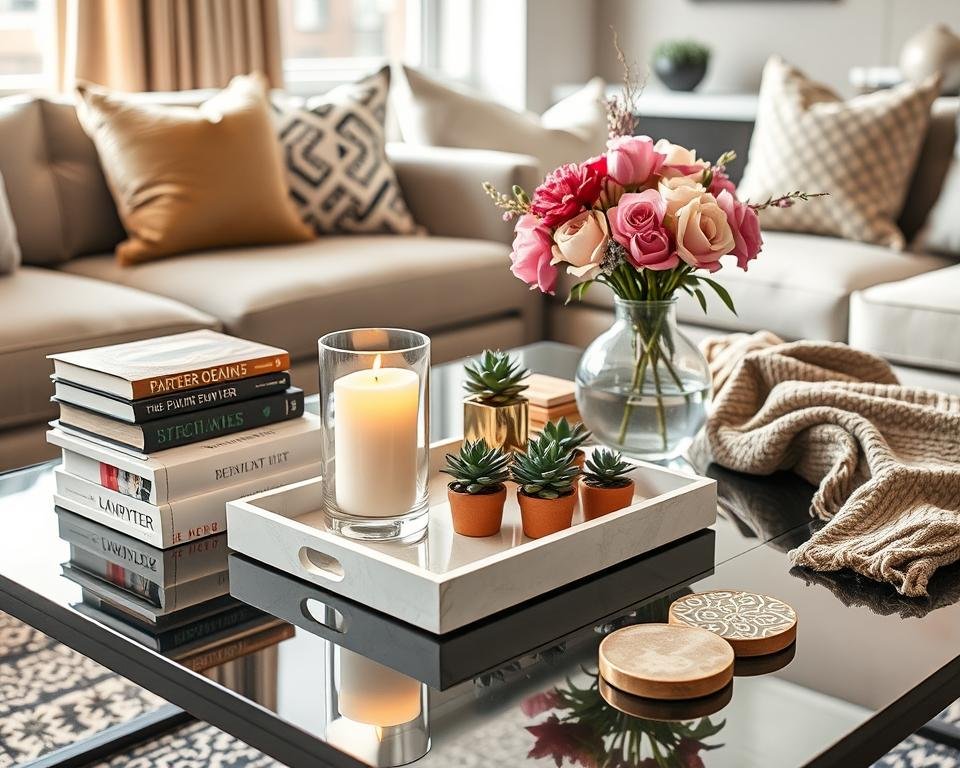
The Rule of Three in Coffee Table Design
The rule of three is key in interior design tips and styling inspiration for coffee tables. It says grouping items in threes makes a display balanced and eye-catching. This draws attention to the designer coffee tables.
Height Variation Techniques
To make a coffee table interesting, designers suggest using height variation. You can stack books or mix objects of different heights. For example, a tall vase, a short decorative item, and a medium-sized candle or sculpture work well together.
Material Combinations
Using different materials like glass, wood, and metal adds depth to a coffee table. Grouping three items from different materials creates a display that’s both cohesive and stimulating. It highlights the unique qualities of each piece.
Color Coordination Strategies
Applying the rule of three to colors also improves a coffee table’s look. Designers suggest a main color, a secondary color, and an accent color. This creates a palette that’s both harmonious and visually appealing, matching the room’s design.
| Technique | Example | Benefits |
|---|---|---|
| Height Variation | Stacking books, using objects of different heights | Creates a dynamic and visually interesting display |
| Material Combinations | Grouping glass, wood, and metal items | Adds depth and texture to the arrangement |
| Color Coordination | Using a dominant, secondary, and accent color | Achieves a harmonious and visually appealing palette |
By using the rule of three in coffee table design, you can make your living space more appealing. It helps create balanced and captivating arrangements.
Books and Literature Display Methods
Coffee table books are more than just for reading. They can also decorate your living space beautifully. Whether you love books or just enjoy their look, learning how to display them can make your room stunning.
Choosing the right books is key. Opt for hardcover books with eye-catching covers. They make a bigger impact than paperbacks. Pick books that show your interests and match your room’s style.
Books made for looks can change your coffee table. They might have amazing photos, bold designs, or interesting topics. Visit thrift stores and vintage shops for unique books that make your space special.
Stacking and Arrangement Techniques
Stacking books is a great way to display them. Try different ways, like stacking them horizontally or vertically. You can also use them as risers or leave them open to show off your favorite pages. The rule of three works well, making your display look balanced and appealing.
| Stacking Technique | Styling Tip |
|---|---|
| Horizontal Stacking | Arrange books in a pyramid or zig-zag pattern for added visual interest. |
| Vertical Stacking | Use bookends or decorative objects to support the books and create height variation. |
| Open Books | Display favorite pages to showcase the content and artistic covers. |
Think about colors when stacking your books. Mixing colors can add energy, while matching them can look neat and polished. Adding decorative trays or platforms can also make your display more appealing.
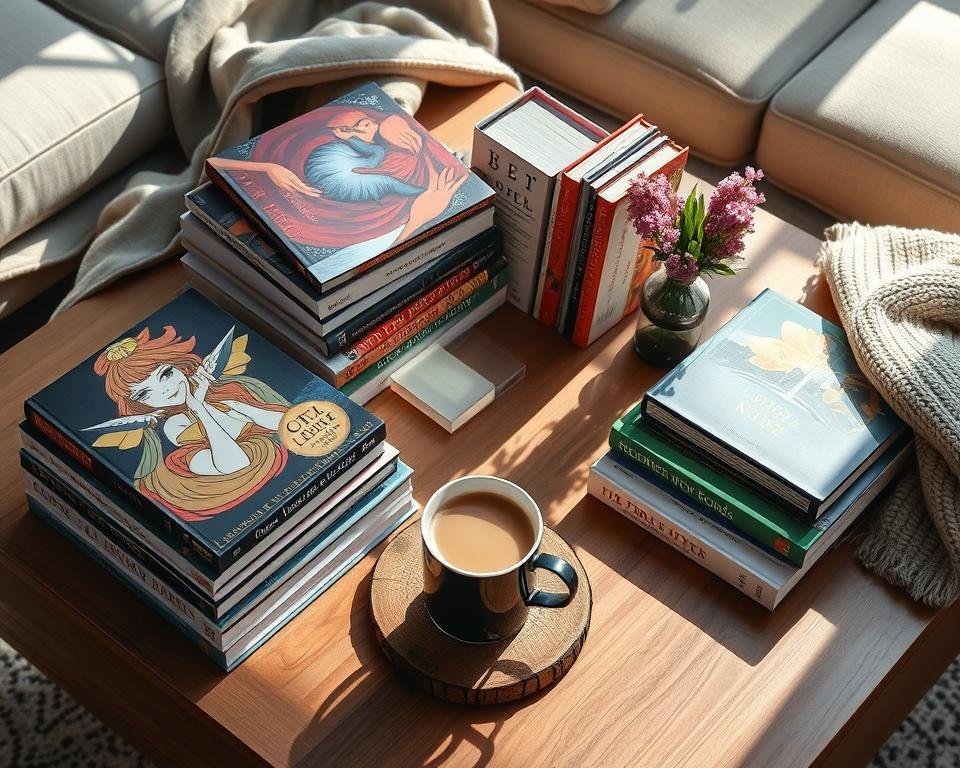
The fun of styling coffee table books is trying new things and showing your personality. Change your book display with the seasons or your interests. Mix books with other decorations for a unique and coffee table books styling inspiration.
Natural Elements and Greenery Integration
Adding natural elements and greenery to your living room can make it come alive. You can use fresh flowers or faux plants. These add texture, color, and life to your coffee table.
Fresh vs. Faux Florals
Choosing between fresh flowers and artificial ones is up to you. Fresh flowers change often and need care. But, faux plants last longer and are easier to keep up with.
Seasonal Plant Selection
- Change your coffee table plants with the seasons to keep your decor fresh.
- Use colorful poinsettias and evergreen sprigs for holiday cheer in winter.
- Spring flowers like tulips or daffodils bring renewal as the seasons shift.
Container Choices for Plants
The container you pick for your plants matters a lot. You can use classic vases, modern planters, or even unique objects. Pick something that fits your decor and adds interest.

| Fresh Florals | Faux Plants |
|---|---|
| Vibrant, ever-changing display | Low-maintenance, long-lasting |
| Require frequent attention | Offer consistent presence |
| Enhance seasonal changes | Maintain year-round appeal |
Adding plants to your coffee table is a great way to make your living room lively. Whether you pick fresh or faux, seasonal or always green, the right plants and containers can make a big difference. They can turn your coffee table into a beautiful centerpiece.
Decorative Objects and Personal Touches
Creating a coffee table that shows your style is all about decorative objects and meaningful personal touches. These elements can turn a simple table into a stunning centerpiece. It shows off your unique personality and taste in design.
Styling a coffee table means mixing objects of different sizes, shapes, and textures. This makes the display interesting and balanced. Sculptures, collectibles, and special items add depth and character to your space.
- Incorporate sculptural pieces that showcase your artistic flair.
- Display meaningful trinkets or mementos that tell a story about your life.
- Arrange a collection of decorative objects that complement the overall interior design tips and curated decor collections in the room.
Decorative objects bring charm and individuality to a space. By choosing and arranging these decorative accents carefully, you can make your coffee table a true reflection of your style. This enhances the look of your living room.
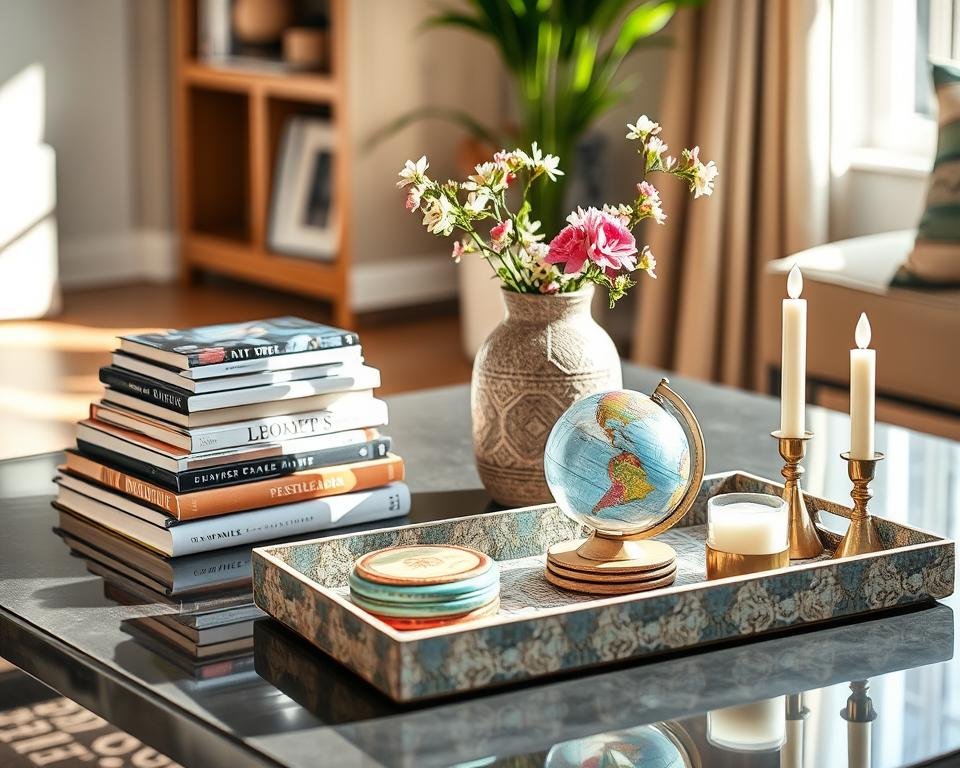
“Decorative objects and personal touches are the heart and soul of a well-styled coffee table. They bring life, character, and a sense of authenticity to the space.”
When styling your coffee table, be creative and follow your heart. Choose objects that are not only beautiful but also meaningful to you and your loved ones.
Tray Styling Techniques and Organization
Trays are key to making your coffee table look great. They help keep things organized and stylish. The right tray can turn a messy table into a beautiful display of your favorite things.
Material Selection for Trays
Choosing the right tray is important. Think about what fits with your coffee table decor and room style. You can pick from metal, rattan, or even marble and wood. Pick something that matches your decor.
Layering and Grouping Items
To make your tray look good, layer and group items well. Use different heights and textures to create a balanced look. Group items in odd numbers for a more natural feel. Don’t forget to leave space to avoid clutter.
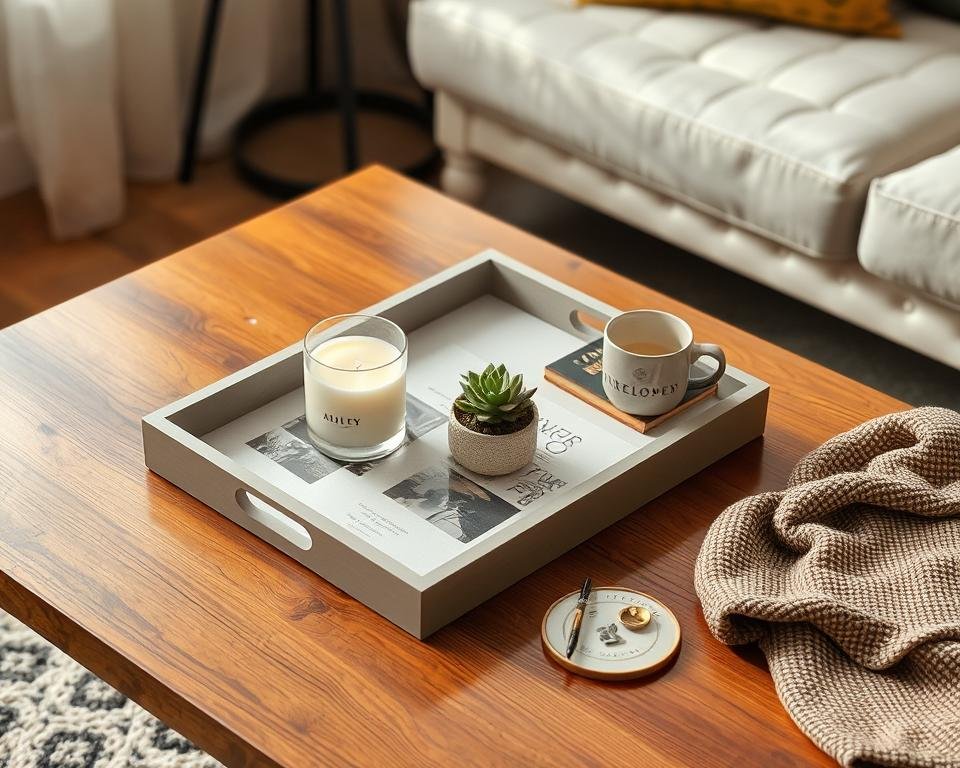
“Trays are the secret to effortlessly styling your coffee table. They provide a canvas to showcase your favorite styling inspiration and keep everything neatly organized.”
Learning how to style trays can make your coffee table stand out. Try different materials and ways of arranging items. This will help you show off your personal style.
Incorporating Candles and Lighting Elements
Make your living room cozy with candles and smart lighting on your coffee table. Candles warm up the space and look great as part of your living room decor. Mix different candle sizes, styles, and smells to add depth and interest.
For a safer choice, try battery-operated or LED candles. They mimic the flame look without the danger. Match them with candle holders in materials like metal, glass, or ceramic to fit your home decor trends.
Small table lamps can also make your designer coffee tables stand out. They light up your room and add to the mood. Try out different lamp styles, from modern to vintage, to match your taste.
Think about the size of your coffee table when picking candles and lights. Use different heights to make it look interesting. This way, you can make your coffee table area more elegant and inviting.
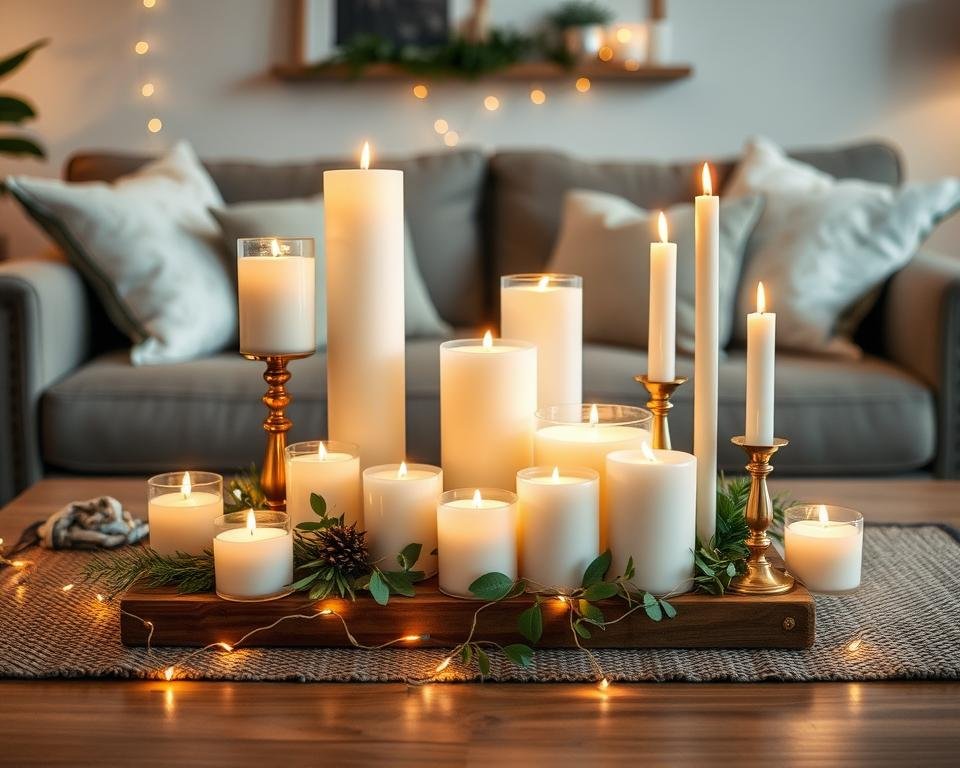
Texture and Material Mixing Strategies
Mixing different textures and materials is essential for a captivating coffee table. This approach adds depth and engages the senses. Let’s dive into combining various finishes for a dynamic look.
Combining Different Finishes
Blend matte, glossy, and metallic finishes for a complex look. For example, pair a polished metal tray with a matte ceramic vase and a brushed brass candlestick. This mix adds sophistication to your decor.
Creating Tactile Interest
- Add smooth, velvety textures like wool or boucle for a cozy feel.
- Pair these soft elements with rougher textures, like natural stone or woven baskets.
- Velvet stands out as a statement piece, while mohair adds warmth and comfort.
Blending materials and finishes creates a coffee table that’s both visually striking and tactilely engaging. This approach inspires your guests and showcases your style. Mix and match to create a unique and inviting space.

The secret to successful mixing is finding a balance between contrasting elements. This ensures a harmonious and striking look that reflects your personal style.
Seasonal Coffee Table Styling
Updating your coffee table decor with the seasons is easy. It can change your living room’s look, making it fresh and appealing. This is a key home decor trend.
Think about the season’s natural materials and colors. In spring, use potted plants or tabletop vignettes with fresh flowers. Summer brings beachy vibes with seashells, driftwood, and woven textures. Autumn is all about cozy with pinecones, gourds, and plaid. Winter adds evergreen sprigs, metallics, and candles.
Change your colors and textures to match the season. This keeps your living room decor looking current and inviting. Seasonal styling makes your coffee table a focal point all year.
| Season | Seasonal Elements | Color Scheme | Textures |
|---|---|---|---|
| Spring | Potted plants, fresh flowers | Bright greens, pastels | Natural, delicate |
| Summer | Seashells, driftwood | Coastal blues, whites | Woven, natural |
| Autumn | Pinecones, gourds | Warm tones, earthy hues | Cozy, textured |
| Winter | Evergreen sprigs, candles | Metallic accents, neutrals | Reflective, glowing |
Embracing seasonal home decor trends keeps your coffee table stylish all year. It makes your living room decor welcoming and eye-catching.
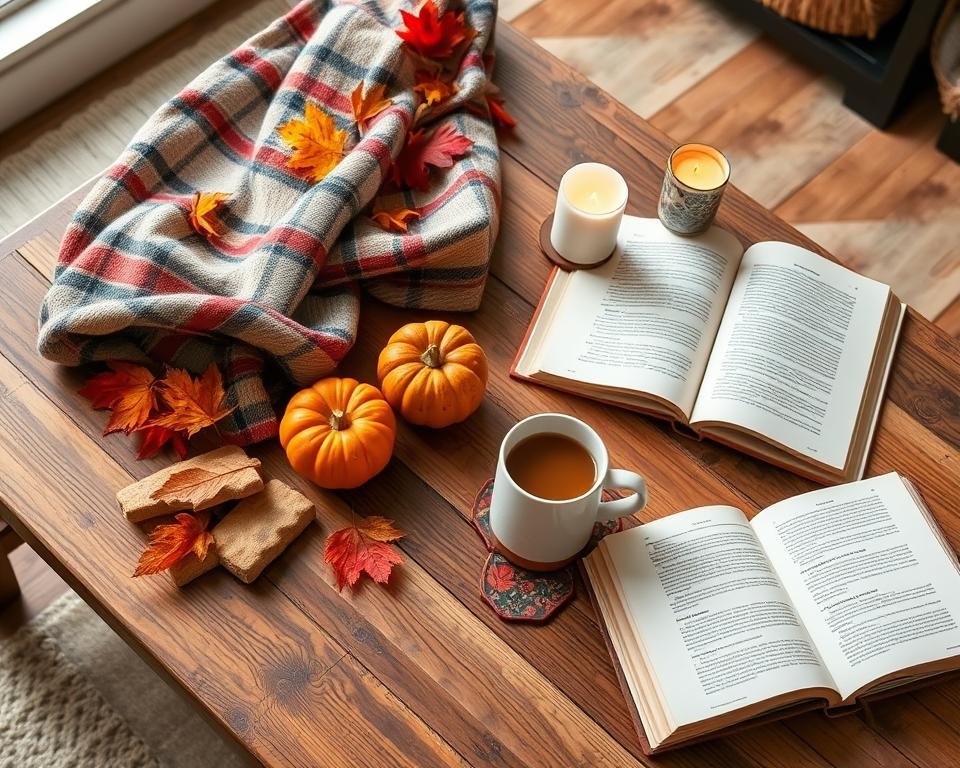
Space Management and Functionality
Effective coffee table styling is more than looks. It’s about finding the right mix of beauty and usefulness. When you’re thinking about interior design tips, remember that your designer coffee tables should be both pretty and practical.
Maintaining Practical Usage
Make sure your coffee table is more than just a piece of furniture. It should be a key part of the room’s layout. Keep a 14–18 inch gap between the sofa and coffee table for easy movement. For sectional sofas, use smaller tables or a nested set to fit each section.
Round or oval tables are great for small rooms because they let people move easily. Also, keep a 2–3 feet gap between the coffee table and the fireplace to prevent accidents.
Storage Solutions
- Choose durable materials like solid Oak or aluminum for family room coffee tables.
- Opt for tables with hidden storage, drawers, or shelves in multi-purpose living spaces.
- Ottomans paired with a tray can serve as coffee tables, ideal for families with children.
Adding storage, like boxes or baskets, keeps your table tidy. It also makes room for things like remote controls or magazines. This way, your coffee table stays useful and central in your living space.
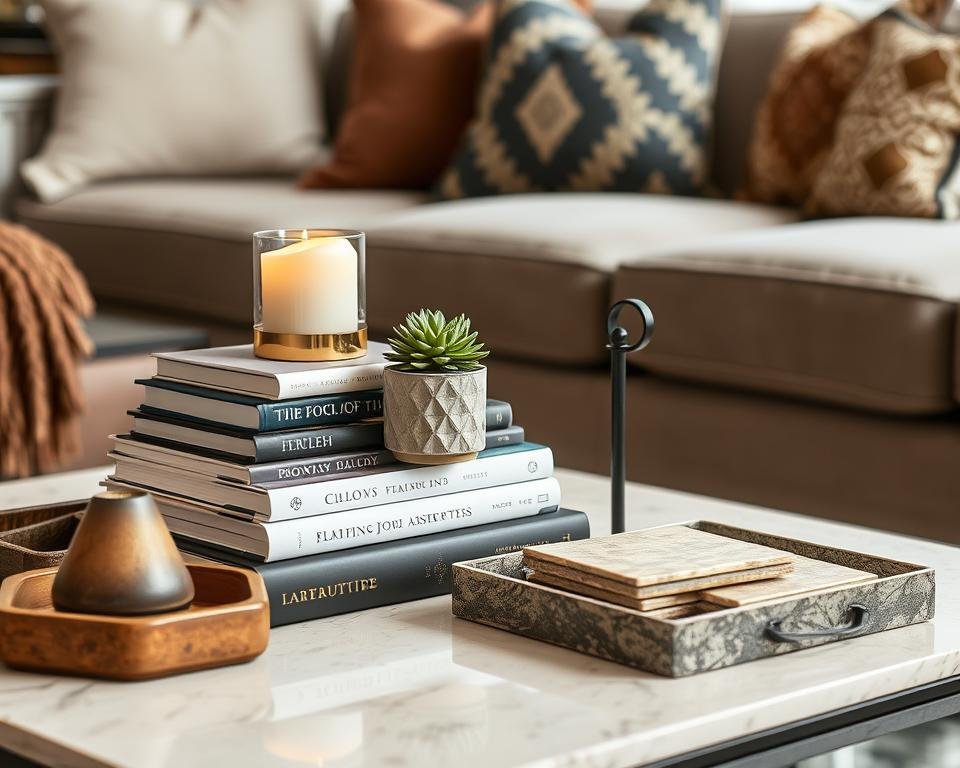
“The key to a well-styled coffee table is to create a balance between form and function. It should be both visually appealing and practical for everyday use.”
Scale and Proportion Guidelines
Mastering coffee table styling means understanding scale and proportion. These design principles are key to a balanced and appealing living room. Make sure your coffee table decor fits the table’s size.
Large coffee tables can handle bold, statement pieces. But, small tables need smaller decor for a balanced look. Mixing object sizes and considering the table’s place in the room creates a balanced space.
The golden ratio, about 1:1.618, guides coffee table styling. It’s found in nature and adds beauty. Using it in decor brings harmony and proportion to your table.
“Measure twice, cut once” – a carpenter’s saying that fits interior design well. Measuring your space and furniture accurately is key for scale and proportion. This detail can make a room feel balanced or cluttered.
Negative space is as important as decor. Enough space around your table makes each piece stand out. This enhances the room’s feel.
Keep these guidelines in mind for a stunning coffee table display. Scale, proportion, and negative space make your living room decor cohesive and captivating.
| Design Principle | Recommended Ratio | Explanation |
|---|---|---|
| Artwork above bed | 1/2 to 2/3 of the space | The ideal artwork above a bed should fill at least 1/2 to 2/3 of the space. |
| Overhead light fixture | Sum of room’s length and width | An overhead light fixture for an entire room should have a diameter equal to the sum of the room’s length and width. |
| Coffee table size | 2/3 the length of the couch | The coffee table should take up 2/3 the length of the couch for proper scale. |
| Dining room chandelier | At least half the width of the dining table | For a dining room chandelier, it should be at least half the width of the dining table for the right scale. |
| Living room rug size | 9×12 instead of 5×8 | Using a 9×12 rug in a large family room makes the space feel larger than a 5×8 rug. |
Color Scheme Coordination
Creating a stunning coffee table starts with thinking about your room’s colors. By matching your coffee table with the room’s colors, you make it part of the home decor trends and interior design tips. Choose colors that go well with the room, making everything look smooth and stylish.
Working with Room Colors
First, look at the main colors in your living area. Are they warm, cool, or a mix? Pick decor that matches these colors. This way, your coffee table will fit right in with the room’s curated decor collections.
Creating Color Harmony
Go for a color scheme that works well together. You might choose one color or add a few accent colors. Mixing textures and materials adds depth and interest to your home decor trends.
The coffee table is the room’s centerpiece. So, the colors you pick are key to the look. By matching your coffee table with the room’s colors, you’ll make a space that’s both beautiful and inviting.
Minimalist vs. Maximalist Approaches
Coffee table styling can be minimalist or maximalist, each with its own look and philosophy. Minimalist styling uses a few key pieces, focusing on empty space and simplicity. Maximalist styling, by contrast, loves abundance, stacking many items to create rich scenes. Both styles can work well if done thoughtfully and in line with the room’s design.
Minimalism isn’t just about cold, grey spaces. It can be warm and welcoming. Designer Laurence Llewellyn Bowen notes that minimalism might seem harsh, as it often removes the soft touches women used to make. Maximalism, on the other hand, welcomes color and patterns, but it needs careful editing to avoid looking messy.
Maximalist design needs as much planning as minimalist design, even if it looks more casual. Fast Co. Design recently said “Minimalism is Dead. Hello Maximalism,” praising bold, luxurious interior designs. The article talked about using rich materials, bold patterns, and global themes, but worried about the waste maximalism might cause.
The article stressed finding a balance between too little and too much. It suggested essentialism as a middle path, focusing on what truly matters in design. Essentialism aims to find a balance between minimalism and maximalism, highlighting what’s essential for personal goals and happiness.
| Minimalist Approach | Maximalist Approach |
|---|---|
| Emphasizes simplicity and negative space | Embraces abundance and layering |
| Neutral color palette, typically earthy tones | Bold and bright colors, often with daring wallpaper |
| Sleek, muted furniture with clean lines and raw materials | Creative and bold furniture choices that stand out |
| Furniture and decor blend into the space | Eclectic feel, reflecting the owner’s personality |
Whether you prefer minimalism or maximalism, the key is to style your coffee table with purpose and balance. This creates a space that’s both beautiful and reflects your personal taste and design choices.
Conclusion
Coffee table styling is an art that blends creativity, function, and personal flair. By using key design rules, mixing different elements, and matching your coffee table with your living room, you can make it a standout piece. It’s important to find a balance between looking good and being useful. Let your coffee table decor grow with your tastes and the seasons.
Learning to use the rule of threes and layering different textures and elements can help you create amazing coffee table displays. These skills will help your coffee table fit perfectly with your living room decor and enhance your interior design. View coffee table styling as a chance to show off your unique style and make your home welcoming.
Whether you like a simple, modern look or a bold, eclectic style, the tips in this article will guide you. They’ll help you create a coffee table that looks great and serves a purpose. It’s time to get creative and turn this key piece into a highlight of your home.
FAQ
What are the key elements for a well-styled coffee table?
A well-styled coffee table needs books, trays, and decorative objects. Natural elements and lighting are also important. These should be balanced and organized for both looks and function.
How can I incorporate the rule of three in coffee table styling?
The rule of three is key in styling your coffee table. Group items in threes for better looks. Use different heights and materials to add interest.
What are some tips for displaying books on a coffee table?
You can display books in many ways. Stack them or use them as risers. Open books with interesting pages can also be art.
How can I add natural elements and greenery to my coffee table styling?
Adding fresh flowers or plants brings life to your table. Faux options are good for easy care. Change them with the seasons to refresh your decor.
What kind of decorative objects can I use to personalize my coffee table?
Use sculptures, collectibles, or meaningful items to make your table unique. Choose items that vary in size and texture for a balanced look.
How can I use trays to organize my coffee table decor?
Trays help organize your decor. They let you group items neatly. Pick trays that match your room and table style.
How can I incorporate candles and lighting elements to enhance the coffee table styling?
Candles and lights add warmth and style. Use scented candles, decorative holders, or small lamps. Mix heights and styles for interest. LED or battery-operated options are safer.
How can I incorporate seasonal elements into my coffee table styling?
Update your table with seasonal items like flowers or pine cones. Change colors and textures with the seasons for a fresh look.
How do I ensure my coffee table remains functional while styled?
Keep your table usable by managing space well. Leave areas clear for drinks or snacks. Use storage like boxes to keep it tidy.
What are the considerations for scale and proportion in coffee table styling?
Scale and proportion are key. Decor should match the table size. Use bigger pieces on large tables and smaller ones on small ones. Balance by varying sizes and considering the table’s place in the room.


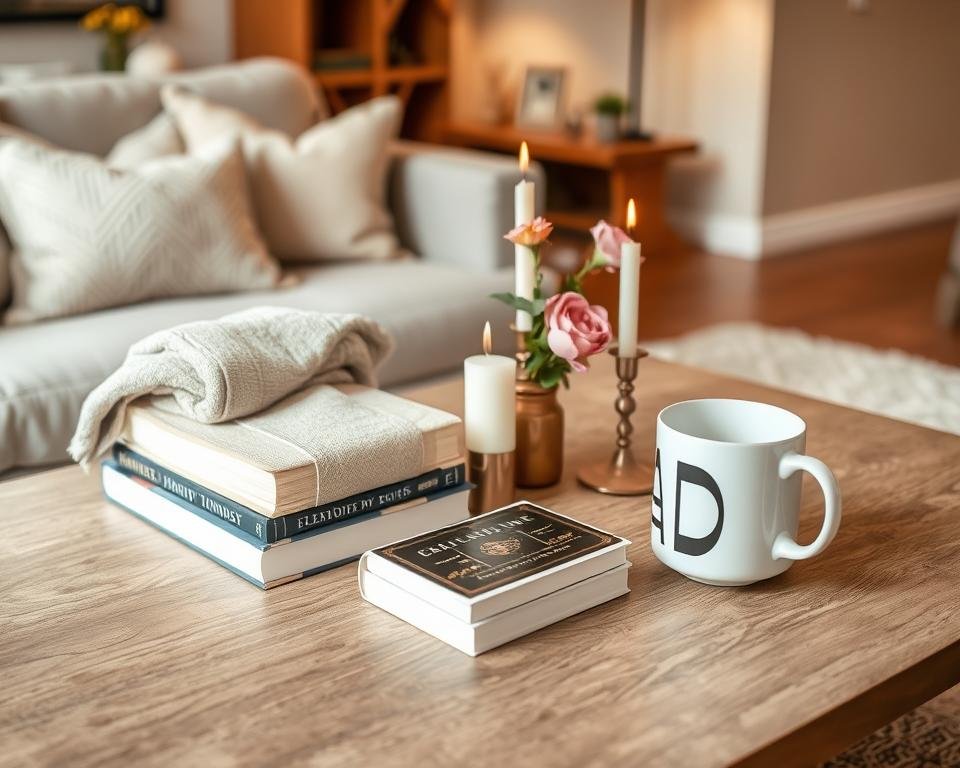
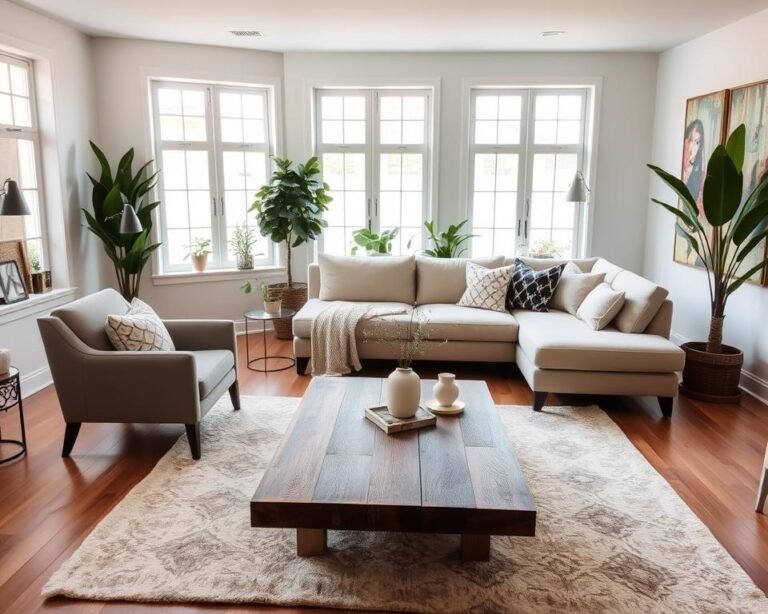
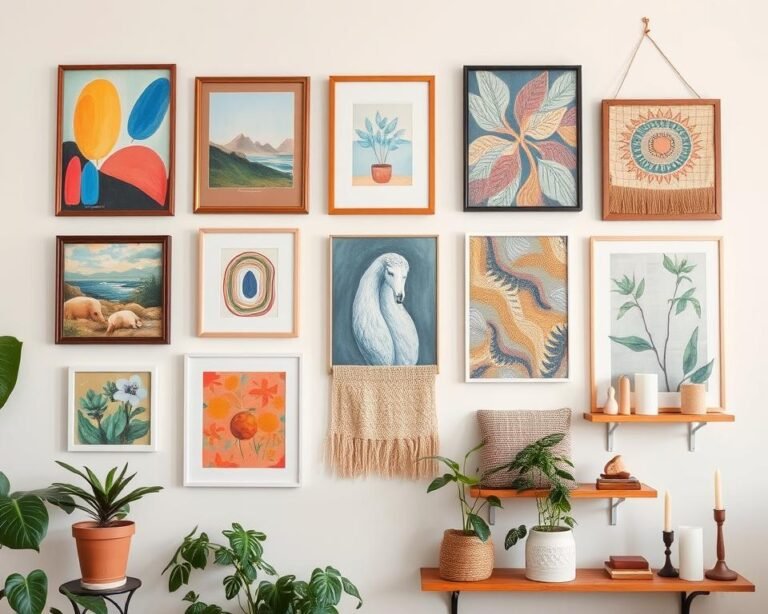
Leave a Comment